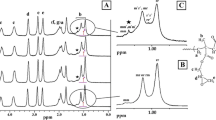Abstract
The solution copolymerization of methacrylic acid (MAA) and ethyl acrylate (EA) was studied by online proton nuclear magnetic resonance spectroscopy (1H NMR) using 2,2′–azobisisobutyronitrile as an initiator in deuterated dimethyl sulfoxide at 60 °C. The chemical compositions of the copolymer and the comonomer concentrations were determined from the conversion of comonomers to copolymer by quantitative in situ NMR monitoring to estimate the reactivity ratios of the comonomers at low conversion. This is a new and easy methodology to analyze radical copolymerization. In this research, it is shown that monomer reactivity ratios can be calculated by data collected only from one initial comonomer mixture composition via online monitoring progress of the copolymerization reaction. The reactivity ratios of MAA and EA are equal to 2.360 and 0.414, respectively. This approach is used to compute the monomer reactivity ratios in a nonlinear integrated form of the copolymerization equation which is described by Mayo and Lewis terminal model. The fairly good agreement between the results and the literature data reported for the emulsion system represent the accuracy of the reactivity ratios calculated by this new approach. The calculated reactivity ratios for emulsion copolymerization are r MAA = 2.040 and r EA = 0.470, and the previous literature data are r MAA = 2.580 and r EA = 0.157.




Similar content being viewed by others
References
Ayaz N, Bezgin F, Demirelli K (2012) Polymers based on methacrylate bearing coumarin side group: synthesis via free radical polymerization, monomer reactivity ratios, dielectric behavior, and thermal stabilities. ISRN Polym Sci 2012:1–13
Hagiopol C, Frangu O, Dumitru L (1989) A nonlinear method for the estimation of reactivity ratios in copolymerization processes. J Macromol Sci Chem 26:1363–1379
Hagiopol C, Frangu O (2003) Strategies in improving the accuracy of reactivity ratios estimation. J Macromol Sci Part A 40:571–584
Meskini A, Raihane M, Ameduri B (2009) Unexpected alternated radical copolymerization of vinylidene cyanide with a fluorinated vinyl ether for superhydrophobic and highly oleophobic films. Macromolecules 42:3532–3539
Kumar KR, Feroz S, Rao PR (2008) Reactivity ratios, thermal and di-electrical properties of 1, 11 azobis (cyclohexanecarbonitrile) initiated nitrile copolymer. Asian J Res Chem 1:58–63
Abdollahi M, Sharifpour M (2007) A new simple procedure to calculate monomer reactivity ratios by using on-line 1H NMR kinetic experiments: copolymerization system with greater difference between the monomer reactivity ratios. Polymer 48:25–30
Aguilar MR, Gallardo A, del Mar Fernández M, San Román J (2002) In situ quantitative 1H NMR monitoring of monomer consumption: a simple and fast way of estimating reactivity ratios. Macromolecules 35:2036–2041
Abdollahi M, Massoumi B, Yousefi MR, Ziaee F (2012) Free-radical homo- and copolymerization of vinyl acetate and n-butyl acrylate: kinetic studies by online 1H NMR kinetic experiments. J Appl Polym Sci 123:543–553
Schuller H (1986) In: Reichert KH, Geiseler W (eds) Copolymerization in emulsion. Huthing and Wepf Verlag, Heidelberg
Bhawal S, Devi S (2002) Recalculation of the monomer reactivity and experimental differences in emulsion and microemulsion copolymerizations of partially water-soluble monomers. J Appl Polym Sci 86:2802–2810
Guillot J (1986) In: Reichert KH, Geiseler W (eds) Computer simulation of emulsion process for monomers of different water solubility. Huthing and Wepf Verlag, Heidelberg
Guillot J (1981) Kinetics and thermodynamic aspects of emulsion copolymerization: acrylonitrile-styrene copolymerization. Acta Polym 32:593–600
Gardon JL (1968) Emulsion polymerization VI Concentration of monomers in latex particles. J Polym Sci A1(6):2859–2879
Bakhshi H, Zohuriaan-Mehr MJ, Bouhendi H, Kabiri K (2010) Emulsion copolymerization of butyl acrylate and glycidyl methacrylate: determination of monomer reactivity ratios. Iran Polym J 19:781–789
Reddy GJ, Reddy MM, Reddy GR, Naidu SV, Reddy AVR (2010) Poly(n-phenyl methacrylamide-co-ethyl methacrylate): synthesis, characterization and determination of reactivity ratios. Malays Polym J 5:68–80
Schork FJ, Luo Y, Smulders W, Russum JP, Butté A, Fontenot K (2005) Miniemulsion polymerization. Springer-Verlag, Berlin
Bajaj P, Goyal M, Chavan R (1994) Synthesis and characterization of methacrylic acid-ethyl acrylate copolymers. J Appl Polym Sci 53:1771–1783
Xinxin L, Kelen T, Xiaomin Y, Pingping W, Zhewen H (1998) Effect of temprature on copolymerization parameters of hydroxyethyl acrylate and methyl methacrylate. Chin J Polym Sci 16:26–31
Author information
Authors and Affiliations
Corresponding author
Rights and permissions
About this article
Cite this article
Ashenagar, S., Ziaee, F. & Jalilian, S.M. Calculation of reactivity ratios of methacrylic acid-ethyl acrylate copolymer by on-line quantitative 1H NMR spectroscopy. Iran Polym J 22, 635–639 (2013). https://doi.org/10.1007/s13726-013-0162-2
Received:
Accepted:
Published:
Issue Date:
DOI: https://doi.org/10.1007/s13726-013-0162-2




